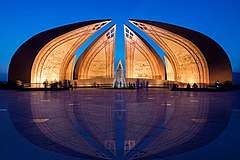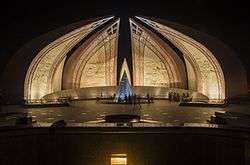Pakistan Monument
The Pakistan Monument (Urdu: یادبود پاکستان) is a national monument and heritage museum located on the western Shakarparian Hills in Islamabad, Pakistan. The monument was constructed to symbolize the unity of the Pakistani people. It is dedicated to the people of Pakistan who sacrificed their "today" for a better "tomorrow". Its elevation makes the monument visible from across the Islamabad-Rawalpindi metropolitan area and is a popular tourist destination.[1]
| Pakistan Monument | |
|---|---|
یادبود پاکستان | |
 Pakistan Monument | |

| |
| General information | |
| Type | Public monument |
| Architectural style | Mughal |
| Location | Islamabad, Pakistan |
| Coordinates | 33°41′36″N 73°04′06″E |
| Construction started | 25 May 2004 |
| Completed | 23 March 2007 |
| Owner | Ministry of Culture |
| Landlord | Capital Development Authority |
| Design and construction | |
| Architect | Arif Masoud (Artwork by Guchrung) (Marble & Granite work by Stone Forever Pvt. Ltd.) |
| Engineer | Syed Mahmud Khalid |
| Structural engineer | Mushtaq & Bilal |
| Other designers | Khizar Hayat Asghar |
| Main contractor | Universal Corporation (Project Director: Brig Maqbul Ahmad khan SI(M)) |
Design concept
Covering a total area of 2.8 hectares (6.9 acres), the design of the monument is rooted in the rich Mughal architecture of the Subcontinent. Its petal shaped structure is derived from the traditional muqarnas of Mughal architecture. As the architect says: "We should learn from history but not remain in it." He used today's technology to modernize the historical form of the muqarnas. The resultant petal-shaped structure emphasizes the importance of unity and togetherness of the people of Pakistan. Rather than symbolizing the four provinces (as is mistakenly observed), it represents the four different cultures of the people of Pakistan. The four large petals represent each of the four cultures, the Punjabi, the Balochi, the Sindhi and the Pakhtun. The three smaller petals represent: the Minorities, Azad Kashmir and Gilgit Baltistan . All seven petals, though independent of each other, stand together in unison to form the nation of Pakistan. Standing together, they are protecting the star and the crescent of the flag of Pakistan. The star of the flag in the monument is designed in shiny black granite with golden stars, which represent the people who sacrificed their life for Pakistan. The moon crescent is made from stainless steel with inspirational writings of Quaid-e-Azam Mohammed Ali Jinnah and Allama Iqbal. The petals are built of granite (projecting in a suspended cantilever form, among the largest in Asia) and its inner walls are covered with artwork depicting the various landmarks of the Pakistan, such as: Lahore Fort, Badshahi Mosque, Khyber Pass and Minar-e-Pakistan. Other than the Peoples Monument, there is a museum which narrates the history and tells the story of the creation of Pakistan. These two structures are connected by a large piazza, known as the Freedom Plaza. Though the name of the architect–Arif Masoud–is inscribed in stone in the main Dedication Plaque located at the beginning of the main plaza–he has honored all construction workers by placing their hand impressions all along the long walls flanking this Freedom Plaza on both the sides. At the farthest end is a viewing platform which gives a bird's-eye view of Islamabad City.[2][3]
Museum
Adjoining the monument is the Pakistan Monument Museum, which includes a wax museum depicting important events leading to the Pakistan Movement. Furthermore, the facilities includes a reference library, audio-visual archive, conference hall along with a 62-seat capacity auditorium known as Panorama Hall.[4] The complex receives on average received 1500 tourists per day totalling at 0.57 million visitors in 2015.[5] From air the monument looks like a star (center) and a crescent moon (formed by walls forming the petals), these represent the star and crescent on Pakistan's flag.[6] The foundation stone was laid on 25 May 2004, completed in 2006 and inaugurated on 23 March 2007 by President General Pervez Musharaf.[7]
Conception
The plan for a National Monument was first envisioned in 2002 by then President Parvez Musharraf assisted by Uxi Mufti, son of Mumtaz Mufti.[8] The Ministry of Culture was tasked by President Musharraf to organize through Pakistan Council of Architects and Town Planners; a national monument design competition based on the theme of signifying strength, unity and dedication of the people of Pakistan into an icon representing an independent and free nation.[9] From a total of 21 submissions, 3 were short-listed. The final design proposed by Arif Masoud was selected.[10]
Gallery
 Moon at Monument
Moon at Monument Monument
Monument Pakistan Monument by M Amir Mir
Pakistan Monument by M Amir Mir Crescent moon over Monument
Crescent moon over Monument Evening at Monument
Evening at Monument Central platform
Central platform Gardens at Pakistan Monument Islamabad
Gardens at Pakistan Monument Islamabad An entrance gate leading to the monument
An entrance gate leading to the monument Pakistan Monument Museum
Pakistan Monument Museum

 Moon over arches
Moon over arches Pakistan Monument at Night
Pakistan Monument at Night Monument Arches
Monument Arches Sunset at Monument
Sunset at Monument- View of the monument at night
See also
References
- "National Monument: Structure reflects history of Pakistan - The Express Tribune". The Express Tribune. 2013-08-29. Retrieved 2016-06-13.
- InpaperMagazine, From (2011-02-26). "Pakistan National Monument: Reliving history". www.dawn.com. Retrieved 2016-06-13.
- Planet, Lonely. "Attractions in Islamabad & Rawalpindi". Lonely Planet. Retrieved 2019-08-20.
- "Dailytimes | Pakistan Monument Museum attracts people". dailytimes.com.pk. Retrieved 2016-06-13.
- "Visiting Pakistan Monument no more free now". The Nation. Retrieved 2016-06-13.
- "RIS students visit Pakistan Monument". www.thenews.com.pk. Retrieved 2016-06-13.
- Khaleeq Kiani (2006) Rs67bn new schemes approved. Dawn (newspaper). 24 August. Retrieved on 23 March 2008.
- http://www.dailytimes.com.pk/default.asp?page=2010\03\27\story_27-3-2010_pg11_1
- Ministry of Culture, Pakistan Archived 2007-11-16 at the Wayback Machine. Retrieved on 23 March 2008
- "Pakistan Monument: a source of attraction for visitors". The Nation. Retrieved 2016-06-13.
External links
| Wikimedia Commons has media related to Pakistan Monument Islamabad. |